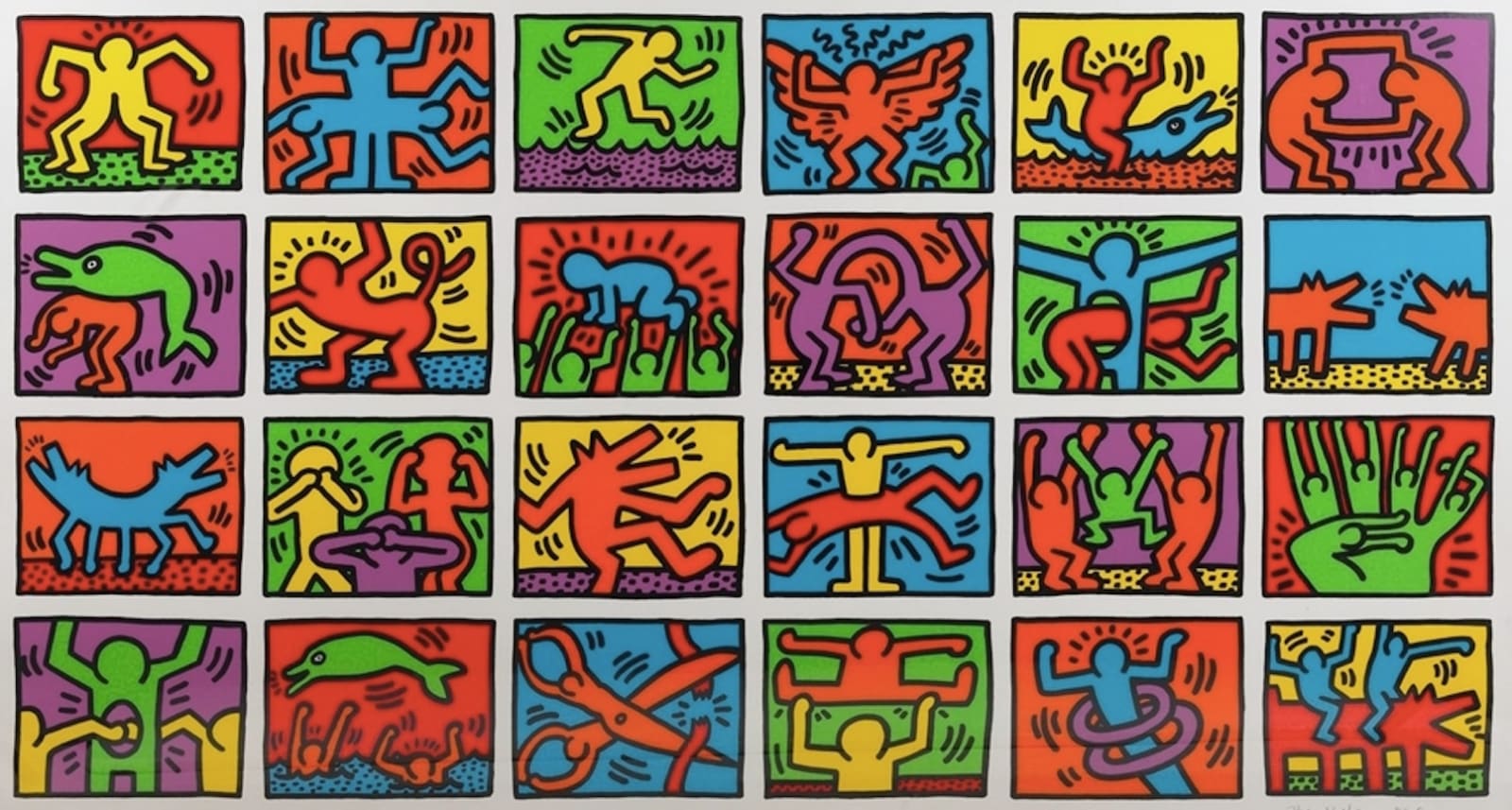Keith Haring’s Retrospect is among the most ambitious and visually striking works in the artist’s print oeuvre. Issued in both color and black & white versions in 1989—just a year before his death—the work serves as a sweeping summation of Haring’s iconographic universe. Retrospect is not simply a print; it is a visual manifesto—a grid of joy, urgency, resistance, and rhythm. It stands as a culmination of Haring’s practice, combining his most recognizable motifs across an extraordinary scale, reaffirming his belief that art is a universal language.
The Format: A Grid of Memory and Motion
The Retrospect series consists of a single massive print, a scale more commonly associated with murals than screenprints. Its colossal size allows for 40 individually framed square panels, arranged in a meticulously structured grid. Each panel features a self-contained artwork rendered in Haring’s trademark graphic language.
The color version bursts with Haring’s signature neon palette—electric pinks, bold reds, acid greens, and bright oranges—outlined in deep, assertive black. The black & white version, in contrast, uses only Haring’s linework. It strips his symbols to their most essential form, offering a stark, almost meditative reflection on his language of signs.
This diptych-like duality—full spectrum and pure monochrome—reinforces the dual impulses in Haring’s art: playfulness and protest, celebration and confrontation, surface simplicity and hidden complexity.
A Catalogue of Iconic Motifs
Across its forty panels, *Retrospect* functions like a visual dictionary of Haring’s most important themes and symbols. The viewer encounters a cavalcade of the artist’s best-known icons:
The Radiant Baby – Haring’s enduring symbol of innocence, purity, and the power of new life.
Dancing Figures – Often shown in pairs or groups, they pulse with energy, representing joy, unity, and community.
Barking Dogs – Both playful and cautionary, these figures oscillate between watchdogs and symbols of authority.
UFOs and Pyramids – Reflecting Haring’s interest in mysticism, extraterrestrial imagery, and ancient civilizations.
Computer Men – Humanoid figures fused with technology, symbolizing the digital age’s encroachment on humanity.
Snakes, crosses, and angels – Recurring spiritual, sexual, and moral themes are woven throughout.
Each motif has been pulled from earlier works—paintings, murals, subway drawings—and recontextualized in Retrospect. Together, they form a visual anthology of the artist’s life-long obsessions.
Colour vs. Monochrome: Two Experiences, One Vision
Retrospect Color
The full-color version, printed in an edition of 75, is visually overwhelming in the best possible sense. The high-impact tones reflect Haring’s 1980s New York roots—graffiti, nightclubs, activism, and street culture—all radiating from the print like neon signage. Color was a central part of Haring’s communication strategy, used not for aesthetic flair but to command attention and provoke reaction.
This version amplifies the diversity of the individual panels. Though part of a single artwork, each image feels like a self-contained message or call to action. The viewer is invited to visually roam, not just from left to right but diagonally, skipping from motif to motif, narrative to narrative.

Keith Haring Retrospect for sale
Retrospect Black & White
Printed in a larger edition of 250, the black and white version feels more introspective and cerebral. Devoid of chromatic stimulation, it forces the viewer to confront the raw power of Haring’s linework. The contrast gives it a timeless, almost classical presence—closer to ink on parchment or ancient petroglyphs than contemporary street art.
Its stripped-down format also heightens the sense of urgency. Many of the motifs—such as the crucified figure, crawling infants, or emaciated outlines—resonate more starkly in monochrome, invoking Haring’s ongoing themes of mortality, spiritual struggle, and the AIDS crisis.

Keith Haring Retrospect Black and White for sale
Monumentality in Printmaking
Unlike traditional prints that fit comfortably in domestic spaces, Retrospect commands a wall, a room, even a viewer’s full field of vision.
This scale serves several purposes:
1. Public Address – Haring, who began his career making drawings in subway stations, understood the importance of scale in communicating with the masses. Retrospect is his mural-in-a-box—a transportable wall of messages.
2. Democratic Multiplicity – As a screenprint edition, it bridges the gap between high art and mass production. The concept of reproducibility, central to Pop Art and embraced by Haring, is here enacted on a spectacular stage.
3. Legacy Encapsulation – By assembling these motifs in one monumental work, Haring created a visual résumé—a literal retrospective—before his untimely death at age 31.
Critical and Market Reception
At the time of its release in 1989, *Retrospect* was met with intrigue. It came at a moment when Haring was globally recognized yet still polarizing. The work defied categorization: a print too large for most collectors, too accessible for the high-end market, and too joyful for a man facing death.
Over time, however, Retrospect has become one of Haring’s most celebrated and sought-after prints. The color edition is exceedingly rare and commands high six-figure sums at auction, while the black & white version remains a touchstone for collectors seeking a direct connection to Haring’s line, message, and legacy.
A Visual Testament
Keith Haring’s Retrospect is more than a print—it is a visual monument, a coded narrative, and a collective memory. Through it, Haring offers not just a greatest-hits collection of his work, but a parting gift to his audience: a reminder that symbols can change the world, that art can speak louder than words, and that accessibility does not diminish significance.
Whether rendered in riotous color or solemn black and white, Retrospect remains one of the most compelling expressions of Haring’s unwavering belief that “art is for everybody.”
Discover original Keith Haring art for sale and contact our New York and London galleries via info@guyhepner.com for latest availabilities.
